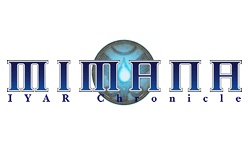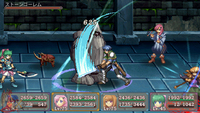|
|

|
PLATFORM
|
PSP
|
BATTLE SYSTEM
|

|
INTERACTION
|

|
ORIGINALITY
|

|
STORY
|

|
MUSIC & SOUND
|

|
VISUALS
|

|
CHALLENGE
|
Very Easy
|
COMPLETION TIME
|
Less than 20 Hours
|
|
OVERALL

|
+ Zany, entertaining characters
+ Excellent voice acting
+ Story focuses on funny character interactions
- Many presentation and interface issues
- Combat is too simple
|
Click here for scoring definitions
|
|
|
When a game begins by introducing the protagonist as a potty-mouthed, lazy, broke, selfish, deadbeat gambling addict in a bar, the immediate lack of sympathy he draws is reminiscent of Luke from Tales of the Abyss. Then the simple, action RPG battle system feels warmly like Star Ocean: First Departure. Later, as the player selects which female party member the protagonist spends an evening with, the Atelier series' humorous character interactions and relationship building come to mind. Whether it is making a stab at inducing nostalgia with old-school vibes or the epitome of an uncreative, generic, safe game from a small developer, Mimana Iyar Chronicle feels first and foremost like a lost action RPG of the 90s, or a remake of a Japanese PlayStation title that never came to America until now. As recognizable as the gameplay is, across the board none of Mimana's components are as strong as they are in the games that came first.
The story focuses on entertaining situations and characters rather than compelling, interesting reasons to run around the world. The protagonist is Crais, a guild mercenary who has no money, no friends, no couth, no drive to succeed, and no problem with any of these flaws. Mimana opens with a mysterious minstrel, Sophie, contracting Crais to follow her around as she collects seven gems. The comedy starts right away — Sophie is a child, Crais despises children; Sophie is cheerful, Crais is a grouch. The humor in the first fourth of the game comes largely from Crais finding new ways to show what a crude jerk he can be, and what makes the dialogue as a whole work so well in Mimana is that as extreme and one-dimensional as the characters can be, the conversations and arguments are always believable; if you can accept that someone like Crais can exist, everything he says fits perfectly.
Mimana puts the player's believability of the characters to the test when a nutty mage with an unhealthy obsession with trying to talk Crais out of his clothing stalks and then joins the party. While Mel is another extreme, one-dimensional character, she's hilarious and her dialogue is so far out there that, if her character can be accepted, one might spend every cutscene laughing for the rest of the game. The script from this point on is pure silly fun as more batty women join up and cutscenes consist of humorous interactions between the odd, flawed characters. Mimana's writing is sharp, and the surprisingly good voice-acting speaks highly of the effort Aksys put into localizing it. Cutscenes are fully voiced, and it's clear that the actors and the director worked to make everything sound realistic. The spot-on pacing to the spoken words here is often missing in English dubs on Japanese RPGs.
 Wait until you hear this line in English with voice acting. It's fantastic.
Wait until you hear this line in English with voice acting. It's fantastic.
|
|
While the localization is wonderfully modern and better than most of today's JRPGs, the combat is a fifteen year step backward. If there is such a thing as a traditional action JRPG, Mimana falls in that category. The player controls Crais, whose only attack is a three move combo executed by hitting the X button three times in a row. He can block, although it's rarely necessary, and that's the whole combat system in a nutshell. Other party members' AIs can be customized in the menu to direct them to attack, heal, or cast offensive magic — and the computer actually follows the strategy set for them, which is nice — but they aren't a huge help and any mage set to only cast spells will literally sit still and let an enemy walk up to her and hit her before she tries to evade, which is weird to see. So as Crais, the player will run around the battle field, executing three hit combos on the enemies while keeping an eye out for monsters who slip past him and might slap around any statuesque mages in the active party. Crais's sword is so powerful that in many cases the player can entirely wipe out all foes before a mage finishes casting a single spell.
There's nothing wrong with simplicity, really, but the random encounter rate is a hair too high and load times before battle are a touch too long, so exploring dungeons becomes a chore more often than not. Backgrounds are incredibly bland with repeated colors and textures, so there is not much going on visually. It's easy to get turned around when the paths in a level all look alike and bend back on each other. This becomes a problem in the more convoluted dungeons, as there is no map at all and the camera's locked viewpoint is too zoomed in to see much in any direction. Trying to exhaustively explore the lengthier, less linear dungeons in the game is boring and frustrating thanks to these issues. Easy fixes like the addition of a minimap or a lower encounter rate would have gone a long way toward making the game enjoyable to play.
 A recycled, pallet-swapped golem being hit by one of Crais's three animated frames of attack.
A recycled, pallet-swapped golem being hit by one of Crais's three animated frames of attack.
|
|
The characters, party, and story have some room for customizability. Equipment upgrades throughout the game have more choices than just wood armor, bronze armor, iron armor, and mythril armor, and party members' strengths and weaknesses can be tweaked by accessories too. More importantly, each character has an element tied to her weapon. Different elements affect different statistics, so there is extra room for customizability. The strongest elemental orbs tend to be found in hidden chests, thus giving the player a reason to explore the mapless dungeons thoroughly. Only Crais can attach any element to his weapon, and he gets a large damage bonus against foes of the opposite element. If most of the enemies in a level are fire enemies, slapping a water orb on Crais's sword will make the easy, fast battles even easier and faster. Between stages, the party sleeps in a hotel and Crais has the option to spend a platonic evening with any one of the all-female support cast he wishes. These bonus cutscenes are fully fleshed out and interesting, often giving insights to Crais's personality as well as the girl's. Mimana's ending changes slightly depending on which female he is closest to, and a gamer wanting to see every character-specific cutscene will need to play through the game numerous times.
Outside of the localization, Mimana has an overall cheap feel to it. Monster designs are lame and pallet-swapped. One of the most repeated enemies is a 3D geometric shape that changes color based on its element. Expect to fight a lot of green cubes, blue cubes, yellow pyramids, orange pyramids, etc. The character sprites used in combat are blown up too big, look absurd, and only have a few frames of animation which is inexcusable on the PSP. While traversing the world, the d-pad and analog stick only register eight-way directional movement, but many of the environments are set off 45 degree angles, so you can't run across the screen in a straight line without changing directions every second. While a couple of the musical pieces are fantastic, most of the score is quite bad and the battle music can get grating when Crais is running around in circles, lost in a dungeon for an hour. There are also framerate issues when exploring dungeons and in battle when too many 3D objects are on the screen at the same time.
Lazy. Generic. Simple. Nostalgic. A light-hearted throwback to 90s gaming. Depending on your viewpoint, Mimana Iyar Chronicle is any or all of those things. It's true that the interface and graphics bring down what could have been a special gem, but the excellent voice acting and laugh-out-loud goofiness of the dialogue and the game's characters make it memorable. Mimana is short — less than twenty hours long — and with the low development and design effort put into it, the initial price point is way too high. It seems priced for Aksys's stellar work rather than the developer's load times, frame rate issues, and copycat mechanics. It's a decent game and worth considering when the asking price matches the short, basic gameplay, and any fan of action JRPGs should enjoy the fun romp. If you dislike action JRPGs, then even the outstanding localization and voice work provided by Aksys can't quite compensate for a game that's too simple and low budget to be great.
Review Archives
|









